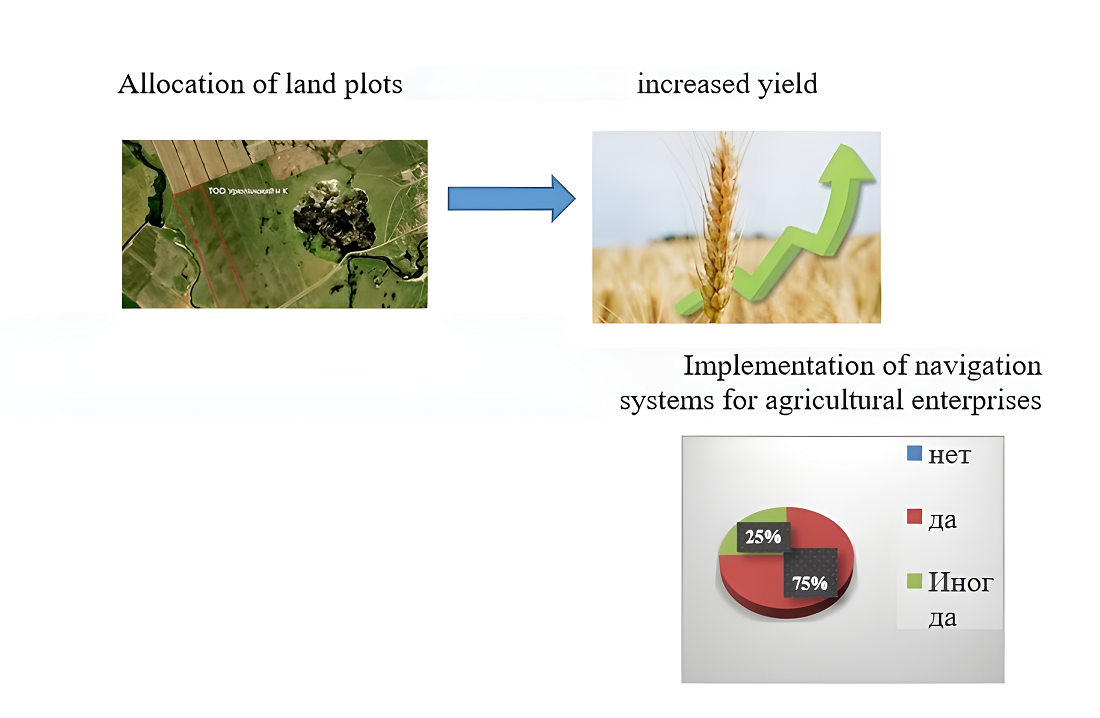Особливості застосування геоінформаційних систем для підвищення врожайності сільськогосподарських угідь
DOI:
https://doi.org/10.15587/1729-4061.2024.309388Ключові слова:
врожайність, моніторинг земель, оптимізація, навігаційна система, аграрні технологіїАнотація
Розглянуто основні проблеми ефективного використання земельних ресурсів, як одного з важливих факторів розвитку країни та забезпечення продовольчої безпеки населення. Проведено дослідження в північному регіоні в Республіці Казахстан, об'єктом дослідження виступили зернові господарства Акмолинської області.
У результаті дослідження зроблено висновок щодо необхідності використання супутникових знімків і безпілотних літальних апаратів для моніторингу посівів та оцінки врожайності в Акмолинській області. Ці технології дозволяють більш ефективно управляти угіддями, оперативно реагувати на проблеми та приймати обґрунтовані рішення. Досвід застосування ГІС-технології у США полягає у формуванні систем баз даних за всіма типами ґрунтів, що мають важливе господарське значення. Функціонують 4 національні бази ґрунтових даних, а також кілька автоматизованих ґрунтових баз даних, що містять інформацію з більш ніж 13400 ґрунтових різновидів. Службою охорони ґрунтів країни створені ґрунтові географічні бази даних, що включають географічну базу даних про ґрунтову зйомку, ґрунтові асоціації штатів, про основні землересурсні райони.
Економічна ефективність заходів щодо консервації земель визначатиметься величиною чистого доходу з урахуванням запобіганих екологічних збитків у вартісній формі, з використанням коефіцієнта ефективності екологічних витрат, віднесеного до загальної суми виробничих та екологічних витрат. Посівна площа в Акмолинській області в середньому за 2018–2023 рр. склала 26264,32 тис. га, середня фактична врожайність зернових становить 12,5 ц/га. На основі застосування наведеної системи формул розрахункова врожайність зернових на нееродованих ґрунтах (Вн) – 13,5 ц/га, а недобір зернових (V) за рахунок еродованості земель – 871,88 тис. ц зерна, що становить за середньої ціни реалізації зерна 80000 тенге/т – 69750 тис. тенге
Посилання
- Transfer i adaptatsiya tekhnologiy tochnogo zemledeliya v rastenievodstve po printsipu «demonstratsionnye fermy (poligony)» Akmolinskoy oblasti. Otchet o nauchno-issledovatel'skoy rabote. TOO «Nauchno-proizvodstvennyy tsentr zernovogo zemledeliya im. A.I. Baraeva» (2020). SHortandy, 240.
- Әlіpbeki, O. Ә., Alipbekova, Ch. A., Sviridenkov, A. O., Shterengarts, A. (2017). Razrabotka prostranstvennyh dannyh na osnove quantum gis i kosmicheskih izobrazheniy landsat. S. Seyfullin atyndaғy Қazaқ agrotekhnikalyқ universitetіnің Ғylym zharshysy(pәnaralyқ) = Vestnik nauki Kazahskogo agrotekhnicheskogo universiteta im. S. Seyfullina (mezhdistsiplinarnyy), 4 (95), 17–28.
- Yeszhanov, G., Mizanbekov, I., Essyrkep, G., Uzbergenova, S., Konkayeva, L., Shunekeyeva, A. (2023). Using GIS technologies to determine the weediness of agricultural crops in the example of the Akmola region. E3S Web of Conferences, 386, 01003. https://doi.org/10.1051/e3sconf/202338601003
- Saiz-Rubio, V., Rovira-Más, F. (2020). From Smart Farming towards Agriculture 5.0: A Review on Crop Data Management. Agronomy, 10 (2), 207. https://doi.org/10.3390/agronomy10020207
- Saparbayev, A. D., Makulova, A. T., Saparbayeva, E. A. (2020). Optimization models of distribution of land plots for grain crops. Problems of AgriMarket, 3, 202–208. https://doi.org/10.46666/2020.2708-9991.25
- Aubakirova, G., Ivel, V., Gerassimova, Y., Moldakhmetov, S., Petrov, P. (2022). Application of artificial neural network for wheat yield forecasting. Eastern-European Journal of Enterprise Technologies, 3 (4 (117)), 31–39. https://doi.org/10.15587/1729-4061.2022.259653
- Ozeranskaya, N., Abeldina, R., Kurmanova, G., Moldumarova, Z., Smunyova, L. (2018). Agricultural land management in the system of sustainable rural development in the republic of Kazakhstan. International Journal of Civil Engineering and Technology, 9 (13), 1500–1513.
- Kurmanova, G. (2014). Regulation of land attitudes in Kazakhstan. IOP Conference Series: Earth and Environmental Science, 20, 012028. https://doi.org/10.1088/1755-1315/20/1/012028
- Shaimerdenova, A. К. (2023). Geographic information systems as an innovative method for increasing the productivity of agricultural land. Problems of AgriMarket, 3, 211–219. https://doi.org/10.46666/2023-3.2708-9991.21
- Beisekova, P., Ilyas, A., Kaliyeva, Y., Kirbetova, Z., Baimoldayeva, M. (2023). Development of a method for assessing the functioning of a grain product sub-complex using mathematical modeling. Eastern-European Journal of Enterprise Technologies, 2 (13 (122)), 92–101. https://doi.org/10.15587/1729-4061.2023.276433
- Svodniy analiticheskiy otchet o sostoyanii i ispol'zovanii zemel' Respubliki Kazahstan za 2018 god.
- Svodniy analiticheskiy otchet o sostoyanii i ispol'zovanii zemel' Respubliki Kazahstan za 2019 god. Available at: http://cawater-info.net/bk/land_law/files/kz-land2019.pdf
- Svodniy analiticheskiy otchet o sostoyanii i ispol'zovanii zemel' Respubliki Kazahstan za 2020 god. Available at: https://www.gov.kz/memleket/entities/land/documents/details/126567?lang=ru
- Svodniy analiticheskiy otchet o sostoyanii i ispol'zovanii zemel' respubliki Kazahstan za 2021 god. Available at: https://www.gov.kz/uploads/2022/4/11/b09469de9be9cc54d2cc0e9cc7a77e84_original.7131188.pdf
- Svodniy analiticheskiy otchet o sostoyanii i ispol'zovanii zemel' respubliki Kazahstan za 2022 god. Available at: https://www.gov.kz/uploads/2024/1/4/528f6bfdb5e70c6bd0c85d001c0a733e_original.6863558.pdf
- Bureau of National Statistics. Agency for Strategic Planning and Reforms of the Republic of Kazakhstan. Available at: https://stat.gov.kz/
- Fontanet, M., Scudiero, E., Skaggs, T. H., Fernàndez-Garcia, D., Ferrer, F., Rodrigo, G., Bellvert, J. (2020). Dynamic Management Zones for Irrigation Scheduling. Agricultural Water Management, 238, 106207. https://doi.org/10.1016/j.agwat.2020.106207

##submission.downloads##
Опубліковано
Як цитувати
Номер
Розділ
Ліцензія
Авторське право (c) 2024 Aigul Shaimerdenova, Faya Shulenbayeva, Adaskhan Daribayeva, Karylgash Chakeyeva, Aziya Kulubekova

Ця робота ліцензується відповідно до Creative Commons Attribution 4.0 International License.
Закріплення та умови передачі авторських прав (ідентифікація авторства) здійснюється у Ліцензійному договорі. Зокрема, автори залишають за собою право на авторство свого рукопису та передають журналу право першої публікації цієї роботи на умовах ліцензії Creative Commons CC BY. При цьому вони мають право укладати самостійно додаткові угоди, що стосуються неексклюзивного поширення роботи у тому вигляді, в якому вона була опублікована цим журналом, але за умови збереження посилання на першу публікацію статті в цьому журналі.
Ліцензійний договір – це документ, в якому автор гарантує, що володіє усіма авторськими правами на твір (рукопис, статтю, тощо).
Автори, підписуючи Ліцензійний договір з ПП «ТЕХНОЛОГІЧНИЙ ЦЕНТР», мають усі права на подальше використання свого твору за умови посилання на наше видання, в якому твір опублікований. Відповідно до умов Ліцензійного договору, Видавець ПП «ТЕХНОЛОГІЧНИЙ ЦЕНТР» не забирає ваші авторські права та отримує від авторів дозвіл на використання та розповсюдження публікації через світові наукові ресурси (власні електронні ресурси, наукометричні бази даних, репозитарії, бібліотеки тощо).
За відсутності підписаного Ліцензійного договору або за відсутністю вказаних в цьому договорі ідентифікаторів, що дають змогу ідентифікувати особу автора, редакція не має права працювати з рукописом.
Важливо пам’ятати, що існує і інший тип угоди між авторами та видавцями – коли авторські права передаються від авторів до видавця. В такому разі автори втрачають права власності на свій твір та не можуть його використовувати в будь-який спосіб.










